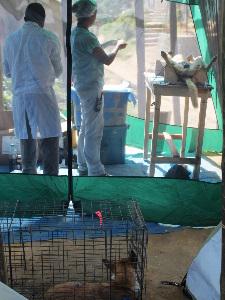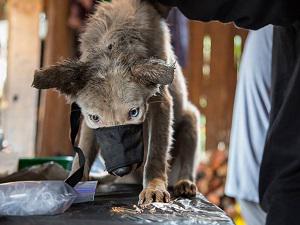Zach J. Farris
Our project aims to address the influx of feral dogs in Madagascar's rainforests and the negative impact they are having on native wildlife in these forests via capture, spay/neuter, vaccination, and relocation of feral and/or domestic dogs. We will also evaluate the effectiveness of a capture/relocate program on reducing dog-wildlife interactions using a combination of photographic surveys and population modeling to assess changes in dog-wildlife interactions and population parameters.

Madagascar is an exceptional biodiversity hotspot, a globally important ecoregion, and an international conservation priority. Madagascar's unique wildlife, including its carnivores and lemurs, face serious threat from widespread habitat loss and fragmentation. In addition, with increases in forest loss and fragmentation there is an influx of introduced, exotic species, particularly domestic and feral dogs. These introduced carnivores pose a threat to wildlife via direct predation, competitive exclusion, and the spread of diseases. Our research recently showed a 30-60% decrease in endemic carnivore occupancy and lemur abundance over a five year period at sites having a strong increase in feral dogs, including strong evidence of 'avoidance' of these exotic species by endemic carnivores species based on co-occurrence models. These early results highlight an alarming trend and demand an effective management strategy that reduces domestic and feral dog numbers throughout Madagascar's forests. We are conducting a targeted research project that will include capturing, spaying, neutering and vaccinating feral dogs, transporting feral dogs to a local shelter for training and placement in permanent homes, and monitoring dog and wildlife populations.

In addition, our vet team will also provide spay/neuter and vaccination services to villages surrounding Ranomafana National Park (RNP) to address the potential increase in the feral dog population. We will conduct surveys at each village to better understand the ultimate causes of why dogs are allowed to go feral within the forest ecosystem and we will assist local conservation organizations in developing targeted education and management decisions to address this issue as they work to conserve biodiversity at RNP.

Finally, we will use historic photographic data (2007-2012) and conduct additional photographic and line-transect surveys of wildlife (2014-2015) within forests near these villages to evaluate the effectiveness of these capture/relocate efforts on wildlife populations. To do so we will use population modeling to assess changes (pre- and post-capture/relocate efforts) in dog-wildlife interactions and population parameters. As these exotic predators and endemic wildlife species are increasingly forced into isolated fragments of forest, predation by exotic predators are impacting endemic wildlife populations that are simultaneously being limited by declining habitat quality and human encroachment. Our project represents the first attempt at developing an applied predator-based strategy to conserve what remains of Madagascar's threatened wildlife.